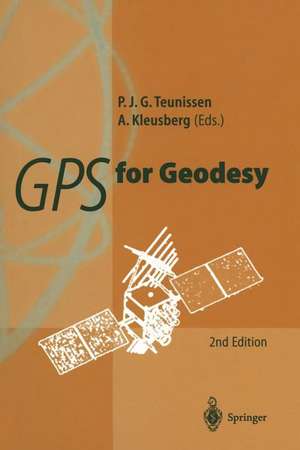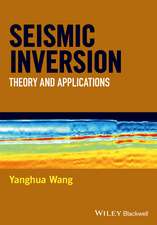GPS for Geodesy
Editat de Peter J. G. Teunissen, Alfred Kleusbergen Limba Engleză Paperback – 10 dec 2011
Preț: 798.66 lei
Preț vechi: 973.98 lei
-18% Nou
Puncte Express: 1198
Preț estimativ în valută:
152.82€ • 166.52$ • 128.78£
152.82€ • 166.52$ • 128.78£
Carte tipărită la comandă
Livrare economică 23 aprilie-07 mai
Preluare comenzi: 021 569.72.76
Specificații
ISBN-13: 9783642720130
ISBN-10: 3642720137
Pagini: 668
Ilustrații: XIV, 650 p.
Dimensiuni: 155 x 235 x 38 mm
Greutate: 0.92 kg
Ediția:2nd ed. 1998. Softcover reprint of the original 2nd ed. 1998
Editura: Springer Berlin, Heidelberg
Colecția Springer
Locul publicării:Berlin, Heidelberg, Germany
ISBN-10: 3642720137
Pagini: 668
Ilustrații: XIV, 650 p.
Dimensiuni: 155 x 235 x 38 mm
Greutate: 0.92 kg
Ediția:2nd ed. 1998. Softcover reprint of the original 2nd ed. 1998
Editura: Springer Berlin, Heidelberg
Colecția Springer
Locul publicării:Berlin, Heidelberg, Germany
Public țintă
ResearchCuprins
1 Reference Systems.- 1.1 Introduction.- 1.2 Transformations between the Celestial and Terrestrial Frames.- 1.3 Time Systems.- 1.4 Motion of the Earth’s Rotation Axis.- 1.5 Earth Deformation.- 1.6 Conventional Reference Systems.- 1.7 The IGS.- 1.8 Summary.- 2 GPS Satellite Orbits.- 2.1 Introduction.- 2.2 Equations of Motion for GPS.- 2.3 The Perturbing Forces Acting on GPS Satellites.- 2.4 GPS Orbit Types.- 2.5 Summary and Conclusions.- 3 Propagation of the GPS Signals.- 3.1 Introduction.- 3.2 Electromagnetic Waves.- 3.3 The GPS Signals.- 3.4 Propagation of Signals in Refractive Media.- 3.5 Atmospheric Refraction.- 3.6 Signal Multipath and Scattering.- 3.7 Summary.- 4 GPS Receivers and the Observables.- 4.1 Introduction.- 4.2 GPS Receivers.- 4.3 GPS Observables.- 4.4 Observation Measurement Errors.- 4.5 Summary.- 5 GPS Observation Equations and Positioning Concepts.- 5.1 Introduction.- 5.2 GPS Observables.- 5.3 Linear Combinations.- 5.4 Single-Receiver NonPositioning Models.- 5.5 The Linearized Observation Equations for Positioning.- 5.6 Relative Positioning Models.- 5.7 Summary.- 6 GPS Data Processing Methodology.- 6.1 Introduction.- 6.2 Equivalence of Pseudorange and Carrier Phase.- 6.3 Equivalence of Stochastic and Functional Models.- 6.4 Frame Invariance and Estimability.- 6.5 Summary and Conclusions.- 7 Quality Control and GPS.- 7.1 Introduction.- 7.2 Validation of Batch Solutions.- 7.3 Validation of Recursive Solutions.- 7.4 Applications to Some GPS Models.- 7.5 Summary and Conclusions.- 8 GPS Carrier Phase Ambiguity Fixing Concepts.- 8.1 Introduction.- 8.2 Integer Least-Squares Adjustment and Testing.- 8.3 Search for the Integer Least-Squares Ambiguities.- 8.4 The Invertible Ambiguity Transformations.- 8.5 The LSQ Ambiguity Decorrelation Adjustment.- 8.6 Summary.- 9 Active GPS Control Stations.- 9.1 Introduction.- 9.2 Active GPS Control Station Components.- 9.3 Single Channel Observation Equations.- 9.4 Real Time Integrity Monitoring.- 9.5 Active GPS Reference Systems.- 9.6 Summary and Conclusions.- 10 Single-Site GPS Models.- 10.1 Introduction.- 10.2 Pseudorange Relation.- 10.3 Direct Solution of Position and Receiver Clock Offset - Bancroft’s Solution.- 10.4 Dilution of Precision.- 10.5 Combining Phase and Pseudorange for Single-Site Determinations.- 10.6 Summary.- 11 Short Distance GPS Models.- 11.1 Introduction.- 11.2 Short Distance GPS Models.- 11.3 Use of Both Pseudoranges and Phases.- 11.4 Disadvantages of Double Differences.- 11.5 Sequential Versus Batch Processing.- 11.6 Network Adjustment - the Final Step.- 11.7 Summary.- 12 Medium Distance GPS Measurements.- 12.1 Introduction.- 12.2 GPS Models at Medium Distances.- 12.3 Analysis Modes.- 12.4 Network Adjustment.- 12.5 Case Studies.- 1.26 Summary.- 13 Long-Distance Kinematic GPS.- 13.1 Introduction.- 13.2 Data Analysis.- 13.3 Testing the Accuracy of Long-Range Kinematic GPS.- 13.4 Conclusions.- 14 The GPS as a Tool in Global Geodynamics.- 14.1 Introduction.- 14.2 The Partial Derivatives of the GPS Observable with Respect to the Parameters of Global Geodynamics.- 14.3 Geodynamical Parameters not Accessible to the GPS.- 14.4 Estimating Tropospheric Refraction.- 14.5 Miscellaneous Orbit Modelling.- 14.6 Satellite- and Receiver- Clock Estimation.- 14.7 Producing Annual Solutions.- 14.8 Results.- 14.9 Summary and Conclusions.- 15 Atmospheric Models from GPS.- 15.1 Introduction.- 15.2 Distribution of Refractivity in the Atmosphere.- 15.3 Vertical Profiles of Refractivity from Radio Signal Occultation.- 15.4 Models for the Ionosphere.- 15.5 Summary and Conclusions.- 16 The Role of GPS in Space Geodesy.- 16.1 Introduction.- 16.2 Space Geodesy in 1997.- 16.3 Performance of the Major Space Techniques in the Recent Past.- 16.4 Space Geodesy: the Future.- 16.5 SLR Observations to GPS Satellites.- 16.6 Summary.
Textul de pe ultima copertă
"GPS for Geodesy" describes the use of Global Positioning System (GPS) measurements for geodetic applications. It covers the modelling and data processing strategies needed for the determination of precise coordinates for position and the monitoring of temporal changes of these coordinates in well-defined reference systems. Starting from the GPS observables, the GPS orbits, the reference frames and the GPS signal propagation characteristics, complete observation equations are presented and discussed for the spectrum of geodetic applications. Models for single-receiver applications are followed by models for multi-receiver applications for which the network scale is used as the criterion. It includes the theory of GPS ambiguity resolution, the contribution of GPS to atmospheric modelling and the use of GPS for geodynamic applications.
Caracteristici
Application aspects - Contributions by GPS researchers of international reputation - Material has been used in 2 International Schools GPS for Geodesy - The text is designed for beginners in the field










